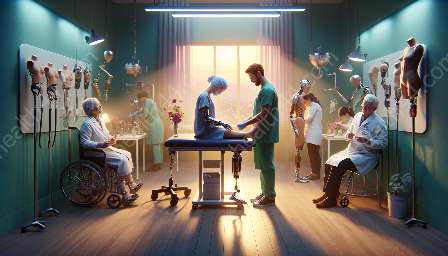Pacemakers are innovative medical devices that have greatly contributed to improving the quality of life for many individuals. These devices are designed to regulate the heart's rhythm and ensure that it functions optimally. In this comprehensive guide, we will delve into the world of pacemakers, exploring their functionality, compatibility with prosthetic devices, and their role in the broader landscape of medical devices and equipment.
The Fascinating World of Pacemakers
Pacemakers are small, implantable devices that are used to regulate the heartbeat in individuals with irregular heart rhythms. They work by monitoring the heart's electrical activity and delivering electrical impulses when necessary to ensure a steady and consistent heartbeat. These devices have evolved significantly over the years, with advancements in technology leading to the development of more sophisticated and reliable pacemakers.
Modern pacemakers are equipped with advanced features such as remote monitoring capabilities, which allow healthcare providers to monitor patients' cardiac activity and adjust the pacemaker's settings as needed. Additionally, some pacemakers are designed to synchronize with the body's natural physiological processes, providing a more seamless and personalized approach to cardiac care.
Compatibility with Prosthetic Devices
One of the remarkable aspects of pacemakers is their compatibility with prosthetic devices. Individuals with pacemakers can benefit from the use of various prosthetic devices, such as artificial limbs or other assistive technologies, without compromising the functionality of their pacemakers. This compatibility underscores the robust design and precision engineering of modern pacemakers, making them suitable for individuals with diverse medical needs.
Furthermore, advancements in materials and manufacturing processes have led to the development of prosthetic devices that are lightweight, durable, and seamlessly integrate with the body. This synergy between pacemakers and prosthetic devices empowers individuals to lead active and fulfilling lives, free from the limitations imposed by cardiac conditions or physical impairments.
Role in the Landscape of Medical Devices and Equipment
Pacemakers are integral components of the broader landscape of medical devices and equipment. They represent a pinnacle of biomedical engineering and technological innovation, embodying the intersection of electronics, materials science, and medical expertise. The continuous enhancement of pacemaker technology continues to redefine the standard of care for individuals with cardiac conditions, offering them a lifeline to a healthier and more vibrant life.
Moreover, the evolution of pacemakers has paved the way for advancements in related medical devices and equipment. It has spurred research and development efforts in areas such as implantable defibrillators, wireless connectivity for remote patient monitoring, and personalized healthcare solutions. The synergy between pacemakers and these complementary devices and technologies forms a cohesive ecosystem aimed at revolutionizing cardiac care and improving patient outcomes.
Advancements and Innovations
The field of pacemaker technology continues to witness remarkable advancements and innovations. From miniaturization and improved battery life to enhanced physiological responsiveness and integration with digital health platforms, pacemakers are constantly evolving to meet the dynamic needs of patients and healthcare providers. These advancements not only optimize the performance of pacemakers but also contribute to the seamless integration of these devices in the context of prosthetic and other medical devices.
Furthermore, the integration of pacemakers with emerging technologies such as artificial intelligence and predictive analytics holds the potential to usher in a new era of personalized and proactive cardiac care. By leveraging data insights and real-time monitoring, pacemakers can adapt to individual physiological variations and anticipate potential cardiac issues, thereby preemptively addressing them and averting complications.
Conclusion
Pacemakers represent a marvel of modern medical technology, serving as a beacon of hope for individuals with cardiac conditions. Their compatibility with prosthetic devices and their pivotal role in the landscape of medical devices and equipment underscore their significance in improving the quality of life for countless individuals. With ongoing advancements and innovations, pacemakers continue to redefine the boundaries of cardiac care, promising a future where individuals can lead fulfilling lives unhindered by cardiovascular challenges.


